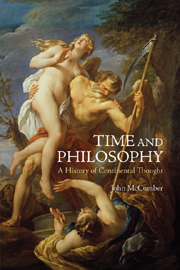Book contents
- Frontmatter
- Contents
- Acknowledgements
- Abbreviations and note on texts
- Introduction
- I Germany, 1790–1890
- 1 The collapse of Kant
- 2 Hegel discovers the past
- 3 Marx, capitalism and the future
- 4 Kierkegaard's dreadful future
- 5 Nietzsche and the boundless future
- II Germany and America, 1900–1968
- III France, 1945–2004
- IV Onwards, 2011–
- Further reading
- Bibliography
- Index
5 - Nietzsche and the boundless future
from I - Germany, 1790–1890
- Frontmatter
- Contents
- Acknowledgements
- Abbreviations and note on texts
- Introduction
- I Germany, 1790–1890
- 1 The collapse of Kant
- 2 Hegel discovers the past
- 3 Marx, capitalism and the future
- 4 Kierkegaard's dreadful future
- 5 Nietzsche and the boundless future
- II Germany and America, 1900–1968
- III France, 1945–2004
- IV Onwards, 2011–
- Further reading
- Bibliography
- Index
Summary
In January 1889, in Turin, Italy, a drayman was whipping an old horse in the street: a common enough, although unpleasant, sight in those days. One of the passers-by, a thin man with pince-nez glasses and an enormous moustache, was terribly moved by the spectacle. He rushed forwards, threw his arms around the horse's neck to stave off the whip, and collapsed. Friedrich Nietzsche regained consciousness, but he was totally insane for the rest of his life.
This was a transformation in Nietzsche's life as profound as any Christian conversion Kierkegaard ever envisaged, but in the opposite direction. Instead of an acceptance of radical freedom, it was a physiological collapse that virtually erased Nietzsche from the human race. Yet in a strange way it was the best thing that ever happened to him. During the previous ten years, in spite of worsening health, Nietzsche had written ten absolutely brilliant books. He is one of the true masters of German prose, indeed one of the very best writers ever to write in any language. But nobody read his books; in several cases he had to pay to get them published. Only after his collapse did the legend spread that his insanity was the result of seeing too clearly, deeply and honestly, and his reputation begin to grow.
Nietzsche, like Marx, was from a clerical family. His father, a Lutheran minister, died in 1849, when he was five; his younger brother, the next year.
- Type
- Chapter
- Information
- Time and PhilosophyA History of Continental Thought, pp. 97 - 124Publisher: Acumen PublishingPrint publication year: 2011

